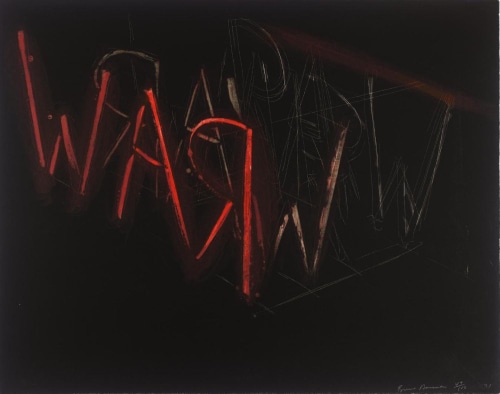
Bruce Nauman
Untitled, 1971
Lithograph, ed. 100
22 1/4 x 28 1/4 in.
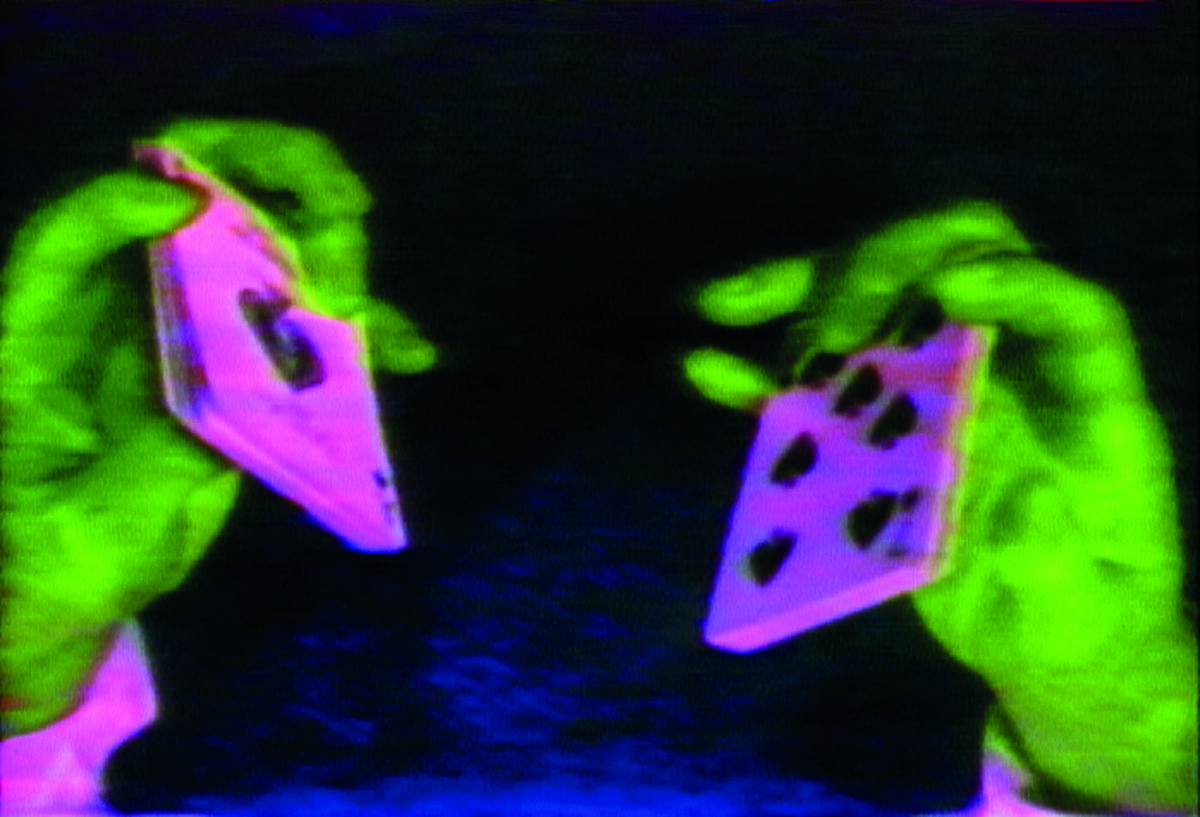
Bruce Nauman Falls, Pratfalls and Sleights of Hand (Clean Version) 1993 Kunstmuseum Wolfsburg © ARS, NY and DACS, London 2020
For more than 50 years Bruce Nauman (born 1941, Fort Wayne, Indiana, United States) has continually tested and reinvented what an artwork can be. His work is difficult to confine to any one movement, genre or medium. However his highly experimental approach makes him a key figure within art today. His interest in ambiguity and shades of meaning relates to daily human experience, where certainty is not always guaranteed.
This exhibition is a survey of Nauman’s work but is not displayed chronologically. It explores how he has been preoccupied by themes such as the artist’s studio, the body, language, and control. His work is full of ideas, and is often described as ‘conceptual’, but he also enjoys playing with material and making objects in the studio.
Throughout his long career, Nauman has refused to assign specific meanings to his artworks. He thereby encourages viewers to bring their own experiences to the work, and to create alternative readings.
ROOM 1
MAPPING THE STUDIO II WITH COLOR SHIFT, FLIP, FLOP & FLIP/FLOP (FAT CHANCE JOHN CAGE) 2001
It helps me to have a sense of place and security to go in the studio, because that’s the place where you make yourself insecure.
MAPPING THE STUDIO II exemplifies Nauman’s curiosity about the usually overlooked aspects of the world surrounding him. Seven large video projections present different views within Nauman’s studio, in New Mexico, US. They were all filmed at night over a period of several weeks. The subject matter is particularly mundane. As a consequence, whenever a mouse, moth or cat enters the frame, it becomes an event.
Nauman has described how, while viewing the individual channels of this work, it is difficult to focus on any one part of an image. ‘You have to kind of not watch anything, so you can be aware of everything’, he advised.
As the title suggests, the images are sometimes digitally ‘flipped’ or ‘flopped’ – turned back to front or upside down. Their colour gradually shifts as the sun rises, heightening the awareness of time passing. The title also refers to experimental composer John Cage (1912–1992). Cage was known for exploring ideas of chance, silence and nothingness in his music and writing. Together with the soundscape of the work, it acknowledges that complete silence in any environment is very rare.
ROOM 2
EARLY WORK
[If] I was an artist and I was in the studio, then whatever I was doing in the studio must be art.
This room presents some of Nauman’s earliest artworks. Following his graduate studies in Fine Art at the University of California, Davis, Nauman was already experimenting with an eclectic range of media. He made performances that he recorded on 16mm film and on video, and created sculptures from everyday materials. From an early stage, he had an unusual interest in sound.
A number of works shown here reveal how Nauman also made use of his own body. He tested its endurance and capabilities through work that involve repetition and manipulation.Among Nauman’s preoccupations at this time was the fundamental question of what it means to be an artist making work in a studio. Working in relative isolation and with modest means, Nauman explored the challenges of being an artist, such as creative anxiety and the pressure to make work that is original.
NEONS
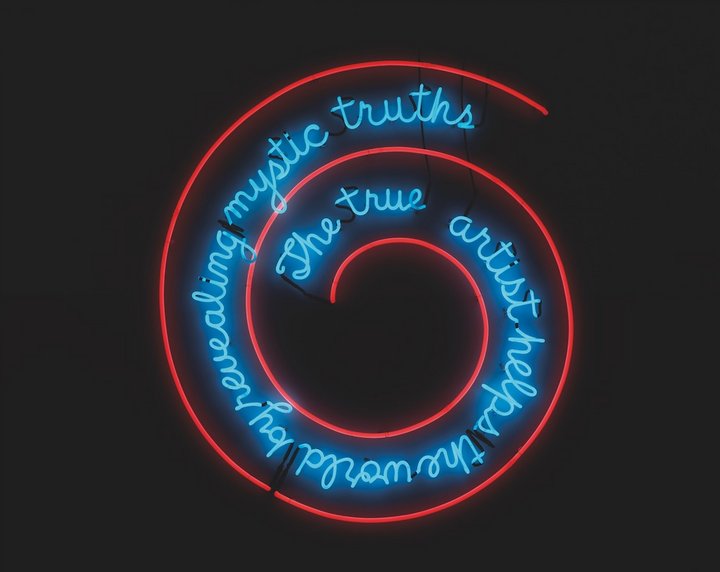
Bruce Nauman The True Artist Helps the World by Revealing Mystic Truths (Window or Wall Sign) 1967 Kunstmuseum Basel (Basel, Switzwerland) © ARS, NY and DACS, London 2020
Nauman made his first neon works in 1965. He refers to them as ‘signs’. They are often text-based, containing wordplay such as puns, anagrams or palindromes. They could be considered conceptual works, playing on both the formal and psychological nature of language. When Nauman began studying art at the University of Wisconsin-Madison, the only course initially available to him was in ‘lettering’. This provided an unlikely foundation for his text based works. It is clear he understands the importance of typography, making use of the emotions and associations conjured up by different letter forms.
The live current within the neon creates a hum, which is especially apparent in larger works, evoking a sense of danger.
ROOM 3
WALKS IN WALKS OUT 2015
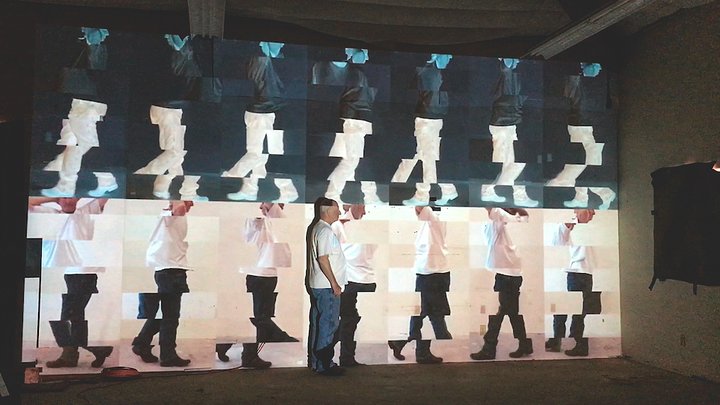
Walks In Walks Out 2015, Tate
In a number of works created since 2015 Nauman has restaged some of the actions from the beginning of his artistic career. Walks In Walks Out was made while he was installing another work, Contrapposto Studies 2015/16, at the Sperone Westwater gallery in New York. Contrapposto Studies was in itself a reworking of Nauman’s Walk with Contrapposto from 1968, seen in room 2. In Walks In Walks Out, Nauman uses his own height as a guide for the installation, walking in and out of the high-definition video projections presented in the gallery. The artist is shown as a living template, personally demonstrating the correct scale for projecting the work in the space. Walks In Walks Out therefore serves as a bridge to works from the very beginning of Nauman’s career when scale was often determined by the size and proportions of his own body.
ROOM 4
CLOWN TORTURE 1987
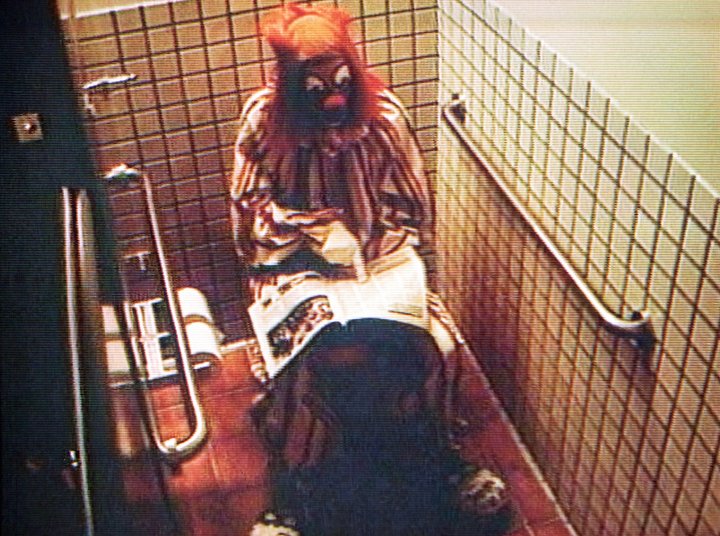
Clown Torture 1987, The Art Institute of Chicago
From his earliest works, Nauman has frequently explored the response of the body to physical and psychological pressure. Here, in contrast to the clowns found in children’s entertainment, he explores the menacing side of this archetype. The clown is played by an actor. Nauman has said:
When you think of a vaudeville clown, there is a lot of cruelty and meanness … Then there’s the history of the unhappy clown...
The clown’s obligation to perform, and to obscure their ‘true’ self, interested Nauman.
As the work is playing continuously in the gallery, viewers can encounter the videos at any given moment. Nauman takes advantage of circular tales that can be understood at any point in the repetitive sequence:
‘Pete and Repeat were sitting on a fence.
Pete fell off. Who was left? Repeat.
Pete and Repeat were sitting on a fence…’
ROOM 5
DOUBLE STEEL CAGE PIECE 1974
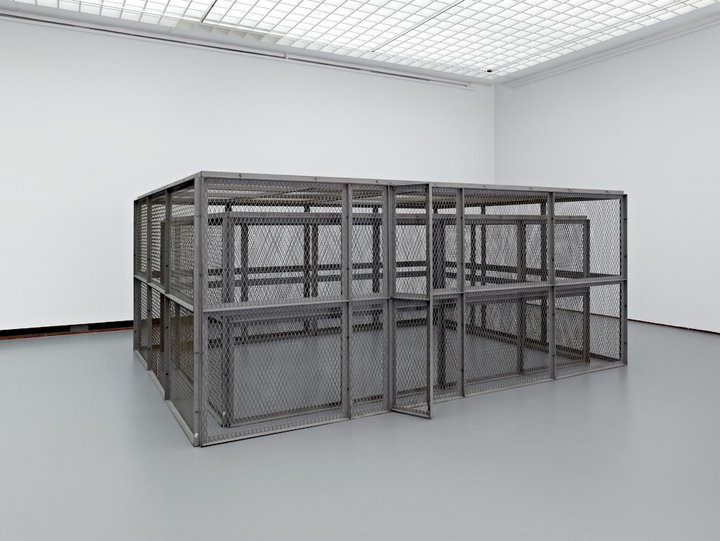
Double Steel Cage Piece 1974, Museum Boijmans Van Beuningen, Rotterdam
Double Steel Cage Piece consists of two cages, one contained inside the other. The work’s modular appearance resonates with minimalist art made in the US during the 1970s. As with other works Nauman made at this time, its dimensions correspond to the size of his own body.
There is a narrow gap between the two cages, barely sufficient for anyone to squeeze through. Nauman recognised that moving sideways along this gap could provoke feelings of anxiety and entrapment. His use of steel mesh, evocative of prison yards, increases this feeling of confinement and surveillance. Nauman intended that the doorway of the cage should be left open, offering viewers the possibility of entering the work. Today at Tate Modern, visitors are not allowed to enter but footage of the experience can be seen on the adjacent screen.
GOING AROUND THE CORNER PIECE WITH LIVE AND TAPED MONITORS 1970
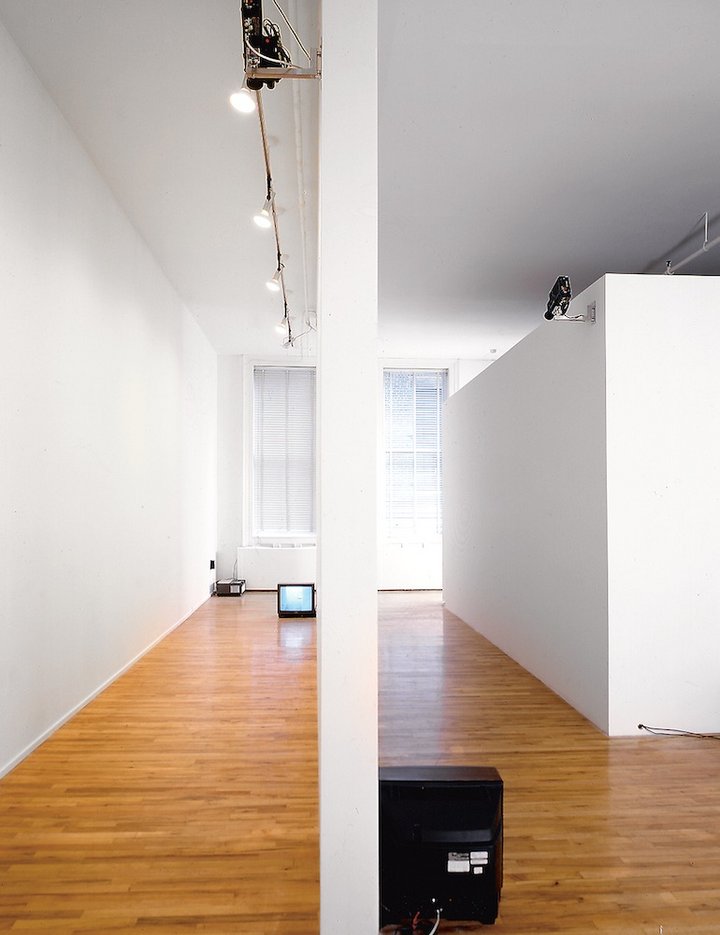
Going Around the Corner Piece with Live and Taped Monitors 1970, Private collection
Encountering this artwork obliges the visitor to be both a viewer and a participant. As we walk towards the monitor on one side of the wall, we become aware that our passage is being recorded from behind by a camera that forms part of a live closed-circuit television system.
However, the monitor is blank. It is only when we turn the corner that we see a fleeting image of our back on the second monitor at the far end of the wall. Nauman is exploring pre-emptive surveillance, where people know they are being watched and feel obliged to regulate their behaviour. CCTV was quite uncommon in the US during the 1970s, unlike today where we frequently see our recorded image through technology.
ROOM 6
MUSICAL CHAIRS 1983
The two chair-like objects in this work have only two legs and lack seats and backs, making them unfit for their original purpose. Hanging from odd angles, there is the chance that they will knock into the steel beams, fulfilling the description within the title.
In Nauman’s work, the chair often represents an absent human figure. Here, the forms of the chairs are unsettling. Critics have suggested that they are stand-ins for victims of political torture. Although his work is rarely overtly political, Nauman has spoken about the impact of reading about the methods of judicial punishment used by political regimes in South America during the 1970s. The title also refers to the children’s game of musical chairs. Nauman’s work repeatedly reveals the darker aspects of children’s games. Describing the cruelty of musical chairs, Nauman has stated:
Somebody is always left out. The first one to be excluded always feels terrible. That kid doesn’t get to play anymore, has nothing to do, has to stand in the corner…
VIOLIN TUNED D E A D 1969
In footage shot with the camera on its side, Nauman stands rooted to one spot in his studio. The violin he is playing is tuned to the notes of D, E, A and D, instead of the usual and more musically rational convention of fifths (G, D, A, E). Describing this work, Nauman has said:
I wanted to set up a problem where it wouldn’t matter whether I knew how to play the violin or not. What I did was to play as fast as I could on all four strings with the violin tuned D, E, A, D. I thought it would just be a lot of noise, but it turned out to be musically very interesting. It is a very tense piece.
ROOM 7
COFFEE SPILLED AND BALLOON DOG 1993
Two videos are juxtaposed to explore everyday failure and the precarious nature of objects. These themes are emphasised by the slow motion of each action and the subsequent distortion of sound. Coffee Spilled references earlier photographic works and drawings exploring the image of a cup of coffee being spilled and Nauman’s earliest-known work, Cup and Saucer Falling Over, made almost 30 years earlier. This illustrates Nauman’s longstanding interest in elevating for consideration the minutiae of the everyday. He regularly revisits his earlier ideas using different media.
ROOM 8
ANTHRO/SOCIO (RINDE SPINNING) 1992
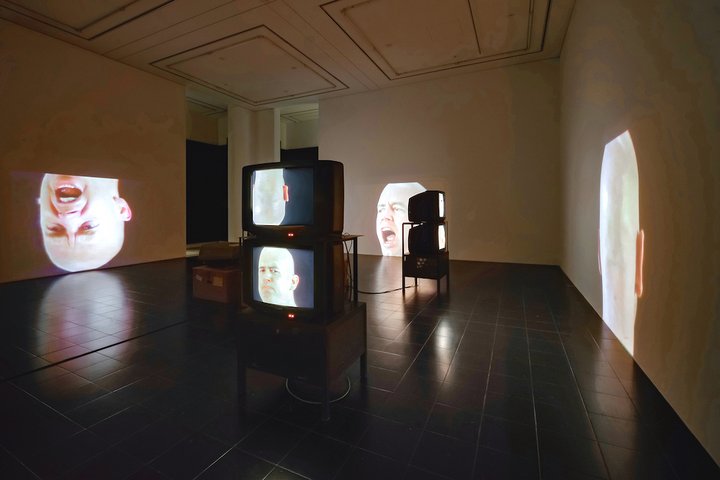
Anthro/Socio (Rinde Spinning) 1992, Hamburger Kunsthalle
Projected on three sides of the room is the rotating, disembodied head of a man. It shouts ‘Feed Me, Eat Me, Anthropology’, ‘Help Me, Hurt Me, Sociology’ and ‘Feed Me, Help Me, Eat Me, Hurt Me’. Aggressive and unsettling, Nauman’s performer screams for fulfilment of the most base human instincts.
Before creating this work, Nauman had been experimenting with making sculptures of heads cast in wax. Anthro/Socio is a translation of this interest into video. He has retained some sculptural elements with the projectors sitting on cardboard boxes, surrounded by stacked monitors.
The performer in this work is classically trained actor and singer Rinde Eckert. Eckert’s skills as a performer are evident. He maintains a consistent, stern expression as he is shouting, making it seem as though his voice is detached from his body.
ROOM 9
ONE HUNDRED LIVE AND DIE 1984
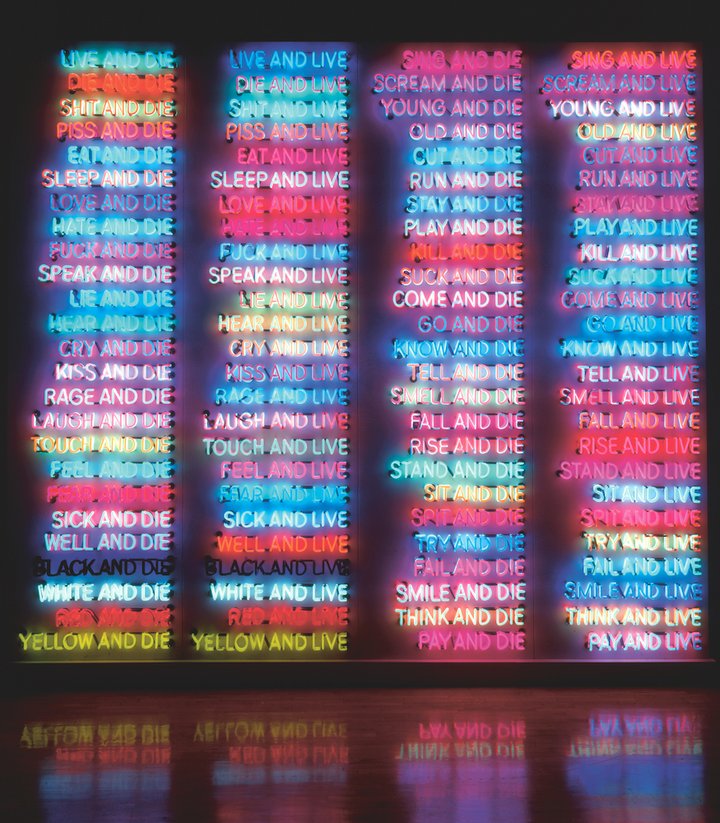
One Hundred Live and Die 1984, Collection Benesse Holdings, Inc./ Benesse House Museum, Naoshima
One Hundred Live and Die shares qualities with Nauman’s earlier work, First Poem Piece, displayed in room 2. Both are composed of a grid of changing declarations. The pronounced hum of the neon evokes danger. The work’s title can be read as a literal description of the one hundred sentences. It also suggests news headlines where individuals become statistics, rounded up to the nearest hundred.
ROOM 10
SHADOW PUPPETS AND INSTRUCTED MIME 1990
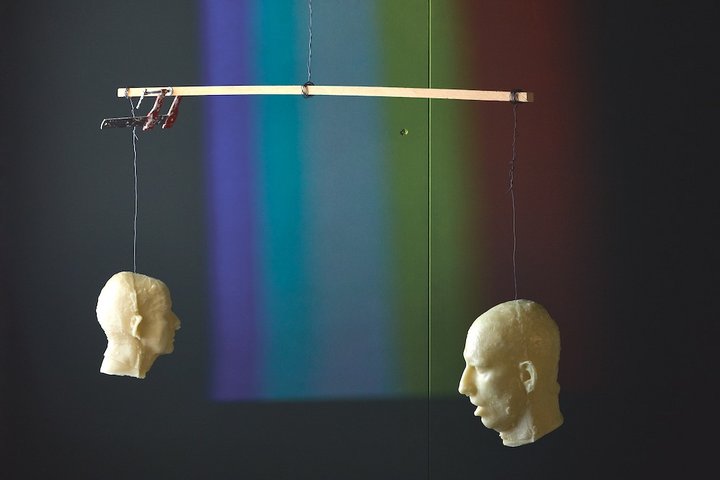
Shadow Puppets and Instructed Mime 1990, Emanuel Hoffmann Foundation
In this installation, viewers are confronted with an array of projectors and monitors. Seemingly random sounds are painstakingly choreographed in a complex playback system. The linen drapes hung in corners of the room conceal suspended wax casts of heads. The shadow play alluded to in the work’s title is created through backlighting.
One of the projected images shows a female mime artist, in costume and full theatrical makeup. She executes movements directed by an off-screen, dispassionate male voice. The viewer becomes witness to a performer being subjected to a series of authoritarian commands. It is difficult to overlook the gendered dynamic between the performer and commander. However, some commentators have written that she asserts her own independence through subtle finger-tapping gestures.
ROOM 11
BLACK MARBLE UNDER YELLOW LIGHT 1981/88
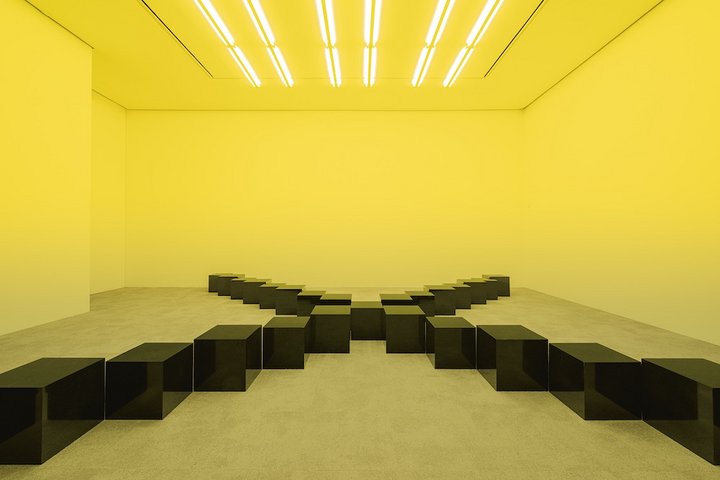
Black Marble Under Yellow Light 1981/88, ”la Caixa” Collection of Contemporary Art, Barcelona
The meaning of this work remains ambiguous, emphasised by the descriptive factual title. This is in contrast to the poetic titles favoured by Nauman for other floor-based, sculptural installations from the late 1970s, which were often accompanied by passages of printed text. The marble blocks are in two slightly different sizes ‘because I thought it disturbed the space in a horizontal way’. Fluorescent lighting is a feature Nauman used in his corridor installations of the early 1970s. Here, the insistent yellow light is chosen for its unsettling qualities, associated with the sodium lights of underpasses and railway goods yards.
ROOM 12
HANGED MAN 1985
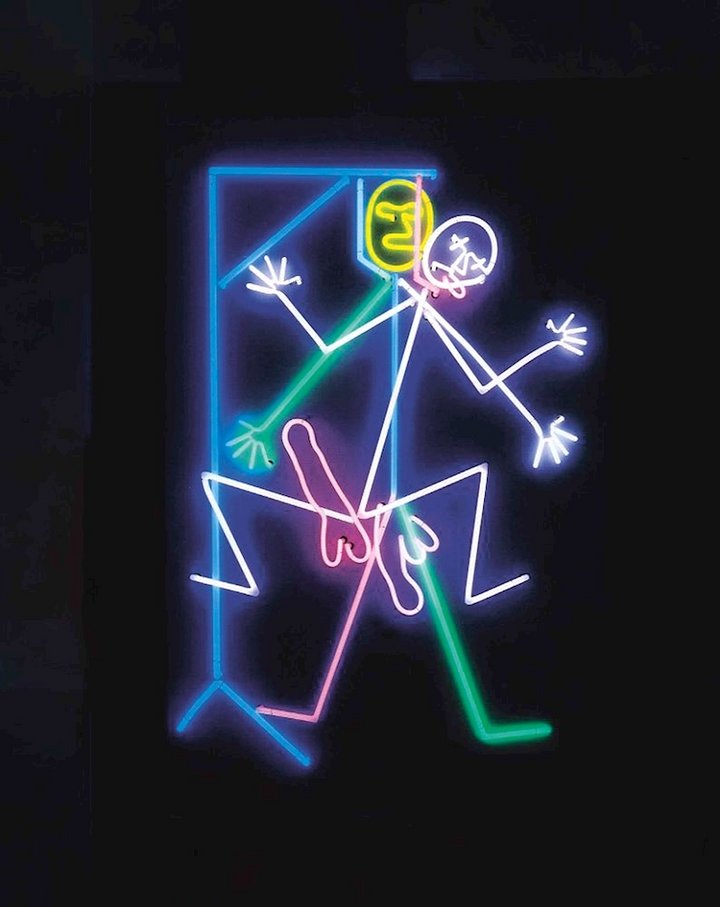
Hanged Man 1985, D.Daskalopoulos Collection
The neon Hanged Man is based on the eponymous children’s game. A player attempts to identify all the letters of a word in the mind of their opponent. Incorrect guesses contribute incrementally towards the sketch of a hanged man. As in Clown Torture, we see Nauman’s interest in the disturbing aspects of children’s entertainment. The original game has a gendered title, ‘Hangman’, but the sex of the figure is not usually defined.
By adding the genitalia, in accordance with the myth that an erection follows the death of a hanged man, Nauman gives his neon an erotic dimension in which sex and death are entwined. Nauman considers the theme of individual agency in this work. He has said:
With my version … you’re not allow to participate – the parts of the figure are put into place without you … And then the game doesn’t end.
ROOM 13
FALLS, PRATFALLS AND SLEIGHTS OF HAND (CLEAN VERSION) 1993
In the main room of this installation, the five videos that comprise the work are titled ‘Gabriel Pratfall’, ‘Belinda Cards’, ‘Mary Falling’, ‘Mark Ball’ and ‘Balloon Dog’. Each was produced using a distinctive RGB colour spectrum. The extreme slowing of action and alternating sound sources create an eerie effect. The monitor presented outside the room shows a preview of what you are about to see. However, its location makes it difficult to confirm that it is actually synchronised, reflecting themes Nauman has explored in earlier work such as Going Around the Corner Piece (displayed in room 5).
Nauman has used finger and hand tricks, deriving from children’s entertainment, magicians and mimes, in a number of his works. This work was in part inspired by a Las Vegas performance he saw in January 1993. Nauman also recalls his grandfather introducing him to magic:
He used to do magic tricks … He’d send us in the kitchen and say, “Get some apples and bananas from your grandmother”, and he’d make them disappear.